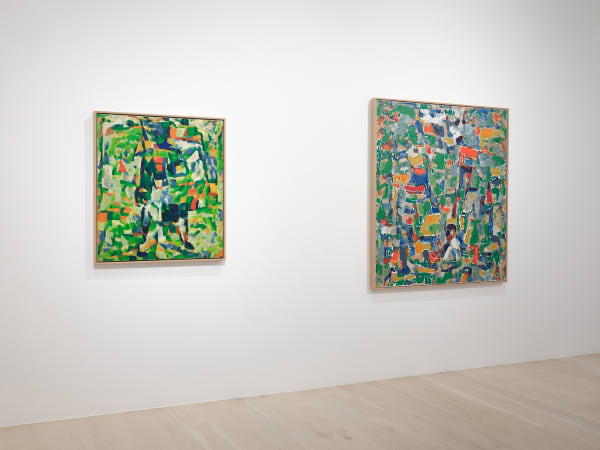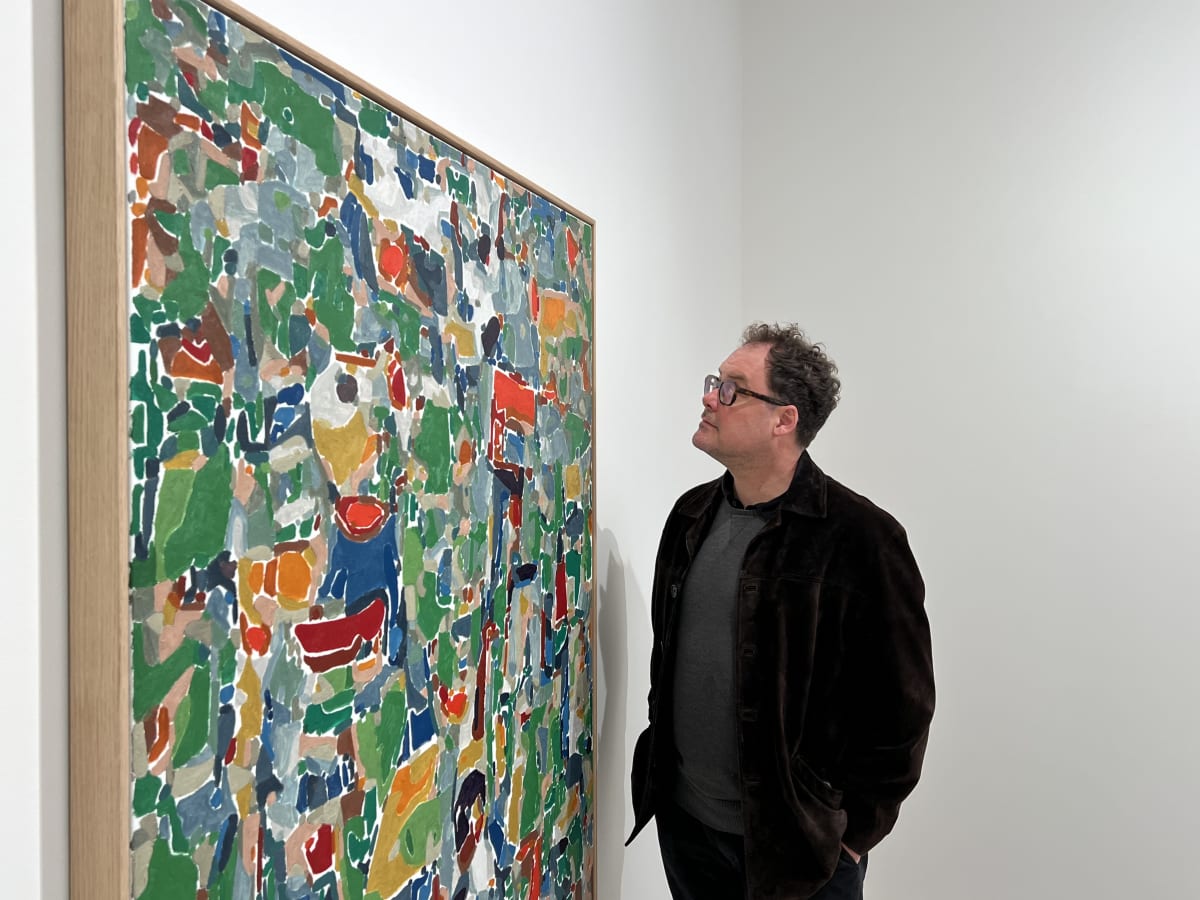Colour Masses in the Fourth Dimension: Simon Ingram
To make these works, Ingram repeatedly used the phrase “Malevich, Painterly Realism of a Boy with a Knapsack - Colour Masses in the Fourth Dimension” to prompt an open-source machine learning tool. This created inputs for the generation of this series of painted compositions.
-
 Simon Ingram, Untitled No. 1 (Painterly Realism of a Boy with a Knapsack – Colour Masses in the Fourth Dimension), 2023
Simon Ingram, Untitled No. 1 (Painterly Realism of a Boy with a Knapsack – Colour Masses in the Fourth Dimension), 2023 -
 Simon Ingram, Untitled No. 10 (Painterly Realism of a Boy with a Knapsack – Colour Masses in the Fourth Dimension), 2023
Simon Ingram, Untitled No. 10 (Painterly Realism of a Boy with a Knapsack – Colour Masses in the Fourth Dimension), 2023 -
 Simon Ingram, Untitled No. 2 (Painterly Realism of a Boy with a Knapsack – Colour Masses in the Fourth Dimension), 2023
Simon Ingram, Untitled No. 2 (Painterly Realism of a Boy with a Knapsack – Colour Masses in the Fourth Dimension), 2023 -
 Simon Ingram, Untitled No. 3 (Painterly Realism of a Boy with a Knapsack – Colour Masses in the Fourth Dimension), 2023
Simon Ingram, Untitled No. 3 (Painterly Realism of a Boy with a Knapsack – Colour Masses in the Fourth Dimension), 2023 -
 Simon Ingram, Untitled No. 4 (Painterly Realism of a Boy with a Knapsack – Colour Masses in the Fourth Dimension), 2023
Simon Ingram, Untitled No. 4 (Painterly Realism of a Boy with a Knapsack – Colour Masses in the Fourth Dimension), 2023 -
 Simon Ingram, Untitled No. 5 (Painterly Realism of a Boy with a Knapsack – Colour Masses in the Fourth Dimension), 2023
Simon Ingram, Untitled No. 5 (Painterly Realism of a Boy with a Knapsack – Colour Masses in the Fourth Dimension), 2023 -
 Simon Ingram, Untitled No. 6 (Painterly Realism of a Boy with a Knapsack – Colour Masses in the Fourth Dimension), 2023
Simon Ingram, Untitled No. 6 (Painterly Realism of a Boy with a Knapsack – Colour Masses in the Fourth Dimension), 2023 -
 Simon Ingram, Untitled No. 7 (Painterly Realism of a Boy with a Knapsack – Colour Masses in the Fourth Dimension), 2023
Simon Ingram, Untitled No. 7 (Painterly Realism of a Boy with a Knapsack – Colour Masses in the Fourth Dimension), 2023 -
 Simon Ingram, Untitled No. 9 (Painterly Realism of a Boy with a Knapsack – Colour Masses in the Fourth Dimension), 2023
Simon Ingram, Untitled No. 9 (Painterly Realism of a Boy with a Knapsack – Colour Masses in the Fourth Dimension), 2023 -
 Simon Ingram, Untitled No. 8 (Painterly Realism of a Boy with a Knapsack – Colour Masses in the Fourth Dimension), 2023
Simon Ingram, Untitled No. 8 (Painterly Realism of a Boy with a Knapsack – Colour Masses in the Fourth Dimension), 2023
"I paint energy, not the soul." [1]
Kazimir Malevich
"Matter is not, in reality, what it appears to be … it is identical with energy and is only a manifestation of the movement of invisible and imponderable elements." [2]
Camille Flammarion
The title of this exhibition responds to Ukraine-born Kazimir Malevich's well-known painting Black Square and Red Square also known as Painterly Realism of a Boy with a Knapsack - Colour Masses in the Fourth Dimension (1915). The title Black Square and Red Square, like many of Malevich's titles, is prosaically descriptive. The work's other title, with its talk of colour masses, a fourth dimension, a knapsack, has always been of great interest to Ingram for the way it points to the playful, pluralist and open nature of abstract painting. Ingram is well known for making paintings with his custom-built painting machines of radio waves, electromagnetic energy, the stuff of the fourth dimension. With Colour Masses in the Fourth Dimension, he takes a refreshing and surprising step.
The idea of a 'fourth dimension,' what Ingram understands via Kandinsky as an 'electric theory of matter' making up a world of invisible energy beyond the material, was widely popular at the time Malevich painted Black Square and Red Square. This stemmed from developments in physics, especially the discovery of x-rays and electromagnetic waves. Many physicists of the era firmly believed in the existence of 'the ether of space,' an omnipresent yet invisible medium that enabled the transmission of waves. This notion was picked up by occultists and philosophers of the time, who attributed many possible phenomena to its existence. According to art historian Linda Dalrymple Henderson, "For occultists, including Theosophists as well as Anthroposophy's founder Rudolf Steiner, the ether offered a powerful model both for vibratory thought transfer and for the interpenetration of spirit and matter [in] ether/matter interactions."[3] Conceptually, this extended into the idea of a 'fourth dimension,' a higher reality of which the three-dimensional world was only a small aspect or subset. Artists of the historical avant-garde, including Malevich, Kandinsky, Duchamp, and others, were highly engaged in occultist discourses, and ideas such as the existence of the ether, and the fourth dimension, were important in their thinking.
To make these works, Ingram repeatedly used the phrase "Malevich, Painterly Realism of a Boy with a Knapsack - Colour Masses in the Fourth Dimension" to prompt an open-source machine learning tool. This created inputs for the generation of this series of painted compositions. If much of Ingram's work engages his machines to do the painting, making generalised machinic versions of painterly traces, here, he turns the tables, seeking to paint like one of his machines. He has painted these works by hand over many hours, and the results are fascinating. In one sense, these works are non-imagistic, painted abstractions. On another, they lend themselves to viewer interpretation, showing nearly discernible images.
Ingram refers to the paintings as 'compositions,' rather than images, as they do not literally depict subject matter. The works present the viewer with a door that can swing both ways - they are abstractions that also lend themselves to interpretation of image. This taps into 'pareidolia' the human tendency to impose meaningful interpretations on a nebulous stimulus. Common examples include seeing faces or animals in clouds, hearing music in random noise. With Ingram's paintings, viewer interpretation can come down to the brain filling in information that isn't in the paint. One can detect natural environments, or cityscapes, or architecture. Or, much like with Ingram's GAN paintings exhibited at Gow Langsford Gallery in 2020, figures. As discussed, the works in Colour Masses in the Fourth Dimension also relate to Ingram's radio paintings from 2012 - 2017, which translate electromagnetic energy into paintings. The common factors running through the artist's work are the visual interpretation of data, often invisible energy, and the creation of informational fields in paint.
Ingram's choice to move away from using machines to do the physical painting in this exhibition was considered. He refers to psychologist Abraham Maslow's 'Law of the Hammer,' which states, "If the only tool you have is a hammer, it is tempting to treat everything as if it were a nail." Ingram felt in this case, at this time, that to use one of his painting machines to create these fourth-dimension paintings would be succumbing to the law of the hammer. He states, "I think good artists make their own sets of rules and constraints, their own customs if you like. This is an important part of painting. Yet, over time to continue operating with one's customs in a meaningful way, it's also important to contradict them, view them from a different vantage point and create space for growth." In this body of work, Ingram has created a conceptually and visually coherent group of artworks that take a profound step in a fresh direction.
Colour Masses in the Fourth Dimension can be seen as a passage through the electric matter of painting. It is a journey into what painting is, and what it can be, exploring painting's historical genealogy and its contemporary setting. Ingram reflects on painting's plurality through machine learning taking the quasi-mystical idea of a fourth dimension and translating it into a poetic, contemporary form of painting.
[1] Kazimir Malevich, 1924, in: 'Khudozhniki na dispute ob AKhRR', in 'Zhizn,' iskusstva 6 (transl. Todd Bludeau); as quoted by Vasilii Rakitin, in The Great Utopia - The Russian and Soviet Avant-Garde, 1915-1932; Guggenheim Museum, New York, 1992, p. 27
[2] Camille Flammarion, Les Forces naturelles inconnues, 1907.
[3] Linda Dalrymple Henderson, "Abstraction, the Ether, and the Fourth Dimension: Kandinsky, Mondrian, and Malevich in Context". Interalia Magazine, November 2020.

























